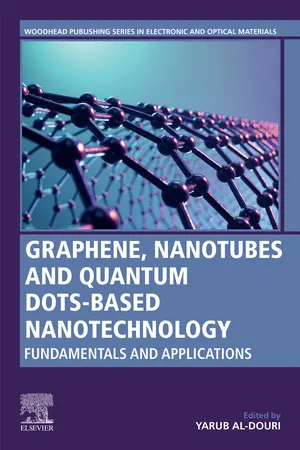
Graphene, Nanotubes and Quantum Dots-Based Nanotechnology
Fundamentals and Applications
- 976 pages
- English
- ePUB (mobile friendly)
- Available on iOS & Android
Graphene, Nanotubes and Quantum Dots-Based Nanotechnology
Fundamentals and Applications
About This Book
A comprehensive look combining experimental and theoretical approaches to graphene, nanotubes, and quantum dots-based nanotechnology evaluation and development are including a review of key applications.
Graphene, nanotubes, and quantum dots-based nanotechnology review the fundamentals, processing methods, and applications of this key materials system. The topics addressed are comprehensive including synthesis, preparation, both physical and chemical properties, both accepted and novel processing methods, modeling, and simulation.
The book provides fundamental information on key properties that impact performance, such as crystal structure and particle size, followed by different methods to analyze, measure, and evaluate graphene, nanotubes, and quantum dots-based nanotechnology and particles. Finally, important applications are covered, including different applications of biomedical, energy, electronics, etc.
Graphene, nanotubes, and quantum dots-based nanotechnology is appropriate for those working in the disciplines of nanotechnology, materials science, chemistry, physics, biology, and medicine.
- Provides a comprehensive overview of key topics both on the experimental side and the theoretical
- Discusses important properties that impact graphene, nanotubes, and quantum dots performance, processing methods both novel and accepted and important applications
- Reviews the most relevant applications, such as biomedical, energy, electronics, and materials ones
Frequently asked questions
Information
Table of contents
- Cover Image
- Title Page
- Copyright
- Table of Contents
- Contributors
- Preface
- Chapter 1 Introduction to graphene
- Chapter 2 Synthesis methods of graphene
- Chapter 3 Chemical properties of graphene
- Chapter 4 Analysis and characterization of graphene
- Chapter 5 Morphology and topography of graphene
- Chapter 6 Mechanical behavior of graphene conductive ink for wearable applications
- Chapter 7 Functionalized 2D materials
- Chapter 8 Graphene oxide
- Chapter 9 Graphene and optoelectronics
- Chapter 10 Synthesis, properties, and application of biomass-derived graphene-like material
- Chapter 11 Application of graphene in supercapacitors, batteries, and fuel cells
- Chapter 12 Introduction to carbon nanotubes and nanoribbons
- Chapter 13 Synthesis methods of nanotubes
- Chapter 14 Chemical properties of carbon nanotubes
- Chapter 15 Physical properties of carbon nanotubes and nanoribbons
- Chapter 16 Analysis and characterization of carbon nanotube
- Chapter 17 Morphology and topography of nanotubes
- Chapter 18 Functionalized nanotubes
- Chapter 19 Mechanical properties of nanotubes
- Chapter 20 Industrial applications of nanotubes
- Chapter 21 Comprehensive multiscale techniques to estimate the compressive strength of concrete incorporated with carbon nanotubes at various curing times and mix proportions
- Chapter 22 Carbon nanostructures and 2D transition metal dichalcogenides
- Chapter 23 Applications of nanotubes in preparation of polymer composite materials
- Chapter 24 Introduction to quantum dots
- Chapter 25 Synthesis methods of quantum dots
- Chapter 26 Optical properties of quantum dots
- Chapter 27 Chemical properties of quantum dots
- Chapter 28 Physical properties of quantum dots
- Chapter 29 Analysis and characterization of quantum dots
- Chapter 30 Morphology and topography of quantum dots
- Chapter 31 Industrial applications of quantum dots
- Chapter 32 Medical applications of quantum dots
- Chapter 33 Environmental impact of quantum dots
- Chapter 34 Quantum dots embedded ceramic materials—Synthesis and application
- Chapter 35 Quantum dots: policy and ethics
- Chapter 36 Quantum dots for modern display devices
- Index